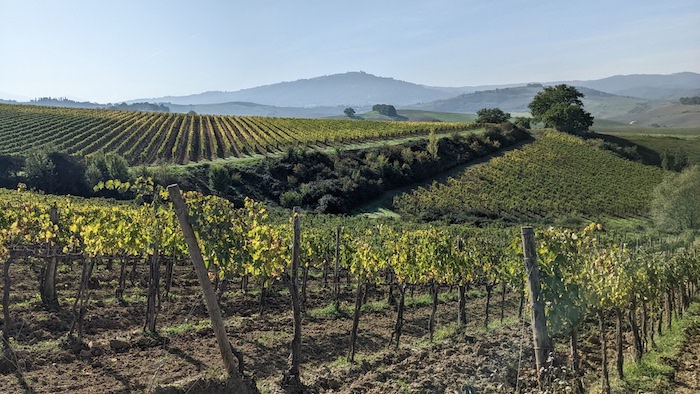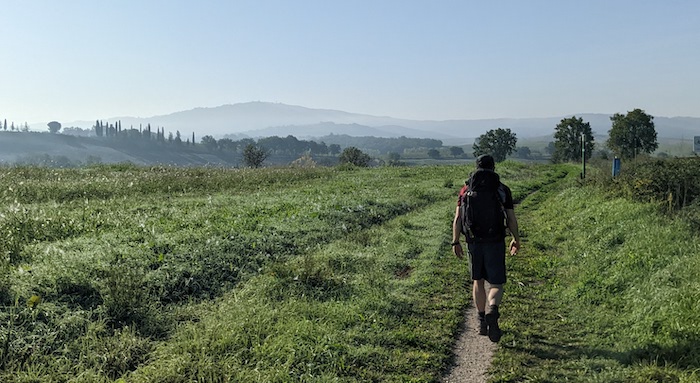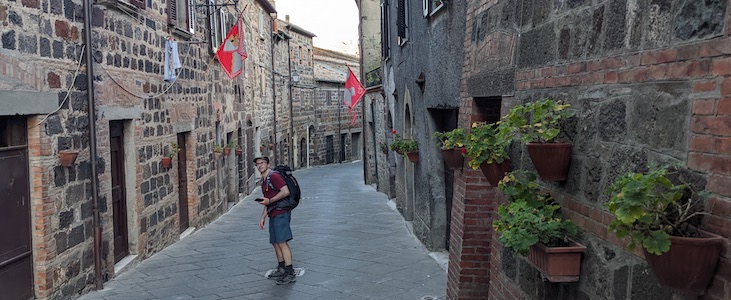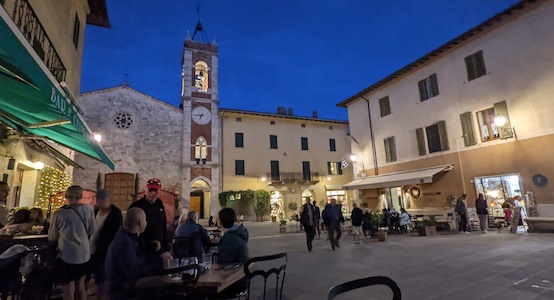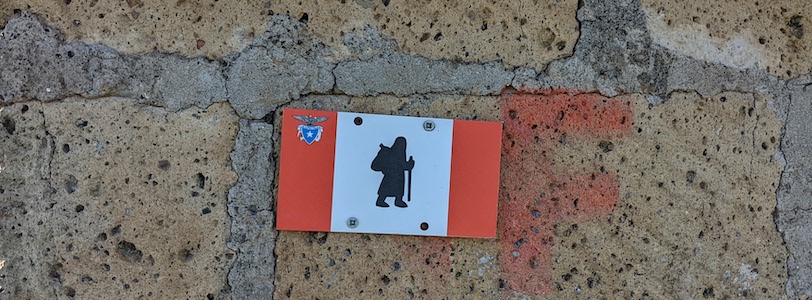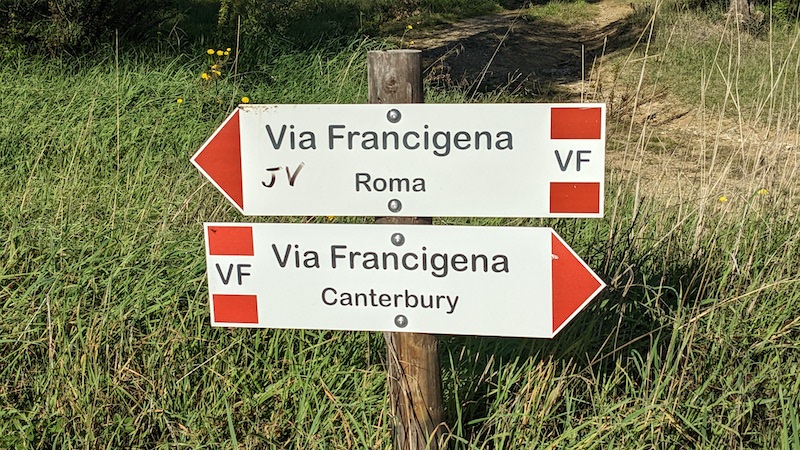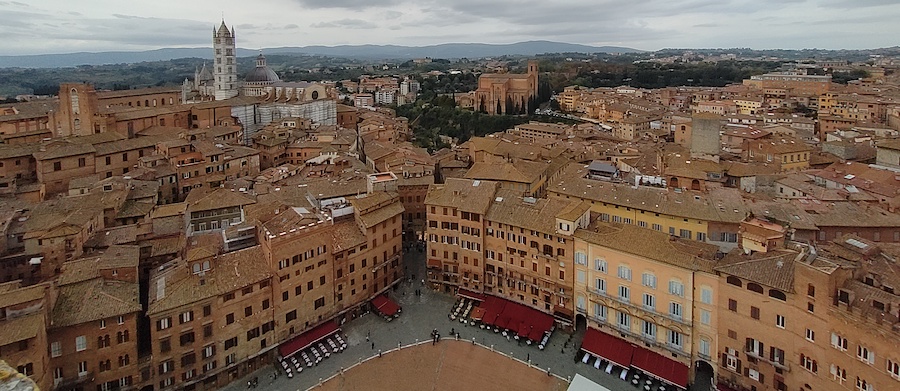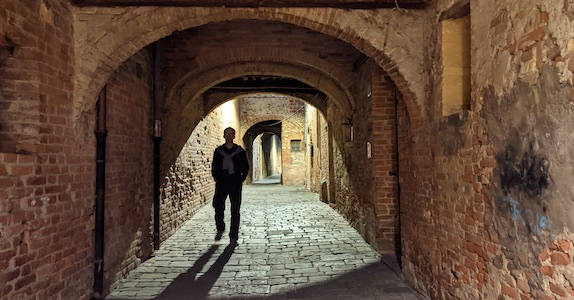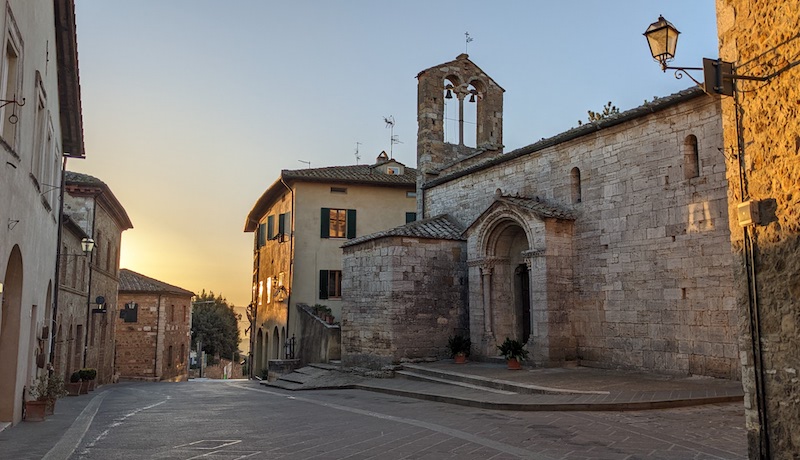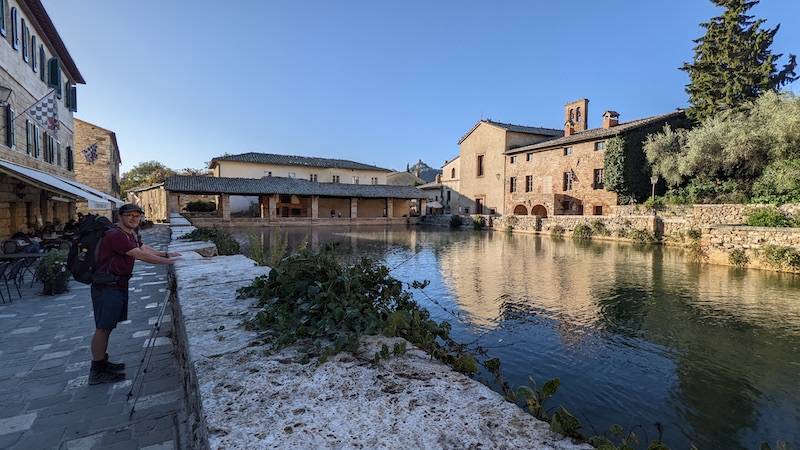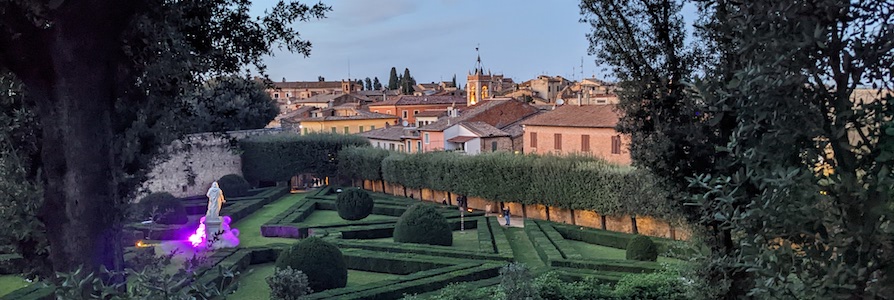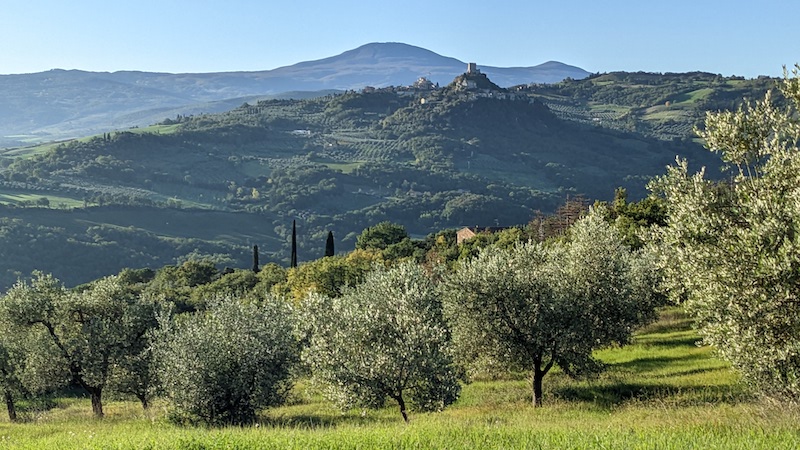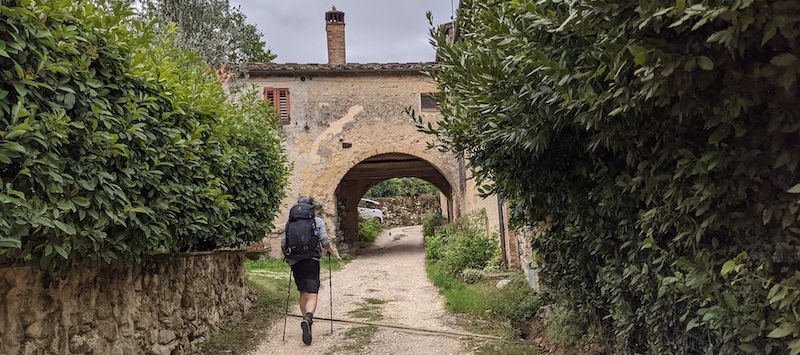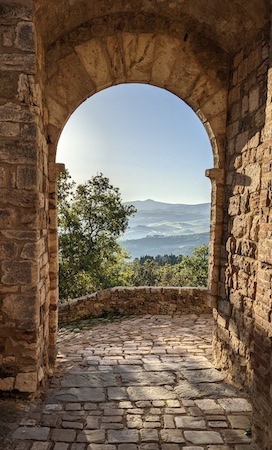Hiking the Tuscan countryside along a historic pilgrim trail
Walking the Tuscan section of this trail late one October, we were captivated by the gorgeous scenery, historic towns well off the beaten tourist track, and spirit of camaraderie along the trail.
OVERVIEW
You’ve probably heard of the Camino de Santiago, a pilgrim trail leading to the Cathedral of Santiago de Compostela in northwestern Spain that has been trod for centuries. The Via Francigena is its counterpart - a 3200km (2000 mile) trail from Canterbury to Rome in the footsteps of Archbishop Sigeric of Canterbury from 990 AD. The very path once followed by crusaders and pilgrims has recently been formalized into a well-marked trail and dubbed Via Francigena (“the road that comes from France”).
Of course, not everyone has the time or desire to walk 25+ kilometers a day for months on end. Many people target especially scenic sections of the Via Francigena over a shorter amount of time. We were so taken by our first five-day experience that we’ve gone back several times and have now covered the last 500km of the VF (from Pontremoli to Rome). Here, we’ve narrowed down the 7-8 day, 165 kilometer (103 mile) stretch of the Via Francigena that we consider the best of the best. It starts in San Miniato, passes through the medieval towns of San Gimignano and Monteriggioni on the way to Siena, then continues through the stunning Val d’Orcia (a UNESCO World Heritage site), before ending in the walled town of Radicofani.
I’ll use a separate post to cover the remaining sections between Pontremoli, Lucca and Rome, which are definitely recommendable if you have the time. If you don’t, however, then this is the section to prioritize. (And if you don’t have 7 days, I’ll make some suggestions at the bottom of this post.)
Unlike the best-known section of the Camino de Santiago (the Camino Francés), which is trampled by 250,000 visitors a year, the Via Francigena isn’t overrun. During our first, end-of-October hike, we met only three people who had started their travels in Canterbury, and they knew of only a handful of others who were farther ahead or behind. Even on the busiest final section from Siena to Rome, we only counted ten hikers setting out on the trail. That made for a perfect mix of solitary hiking and companionship that, together with the historic nature of the trail, gave it an extra-special dimension we haven’t experienced anywhere else. In fact, we liked it so much that we headed back in December for more!
Note: For those with more time, this hike (or part of it) can easily be part of an 8-14 day trip from North America, including time in Florence and Rome. See my post on that here.
PRACTICALITIES
We used Sandy Brown’s excellent book, Walking the Via Francigena Pilgrim Route - Part 3, to guide us on the trail. This compact guide includes everything from detailed maps to local information, accommodation listings, and much more. As it turned out, the trail was so well marked, we rarely needed to consult the map or instructions in the book, but it helped us orient ourselves to the big picture and helped us find groceries, water, etc. Another valuable resource is the Via Francigena website at this link. Finally, I recommend the free, official Via Fracigena app with detailed maps as well as information on accommodations and points of interest.
FOOD and ACCOMMODATIONS
Traditionally, pilgrims stay in pilgrim hostels (cut-rate bunkhouse-type accommodations often run by religious or public institutions for only €10-25 per night). The norm is to call one or two days ahead to reserve. When I tried emailing for reservations weeks ahead of time, I only received a few replies and therefore booked the private accommodations listed below. As it turned out, most of the pilgrim hostels were open and had plenty of space in October, so this was not necessary. We enjoyed a mix of both, with a few nights in hostels mixed with stays in budget apartments (an especially good deal for two or more people).
Many pilgrim hostels usually require a credenziale, which identifies the bearer as an official pilgrim. This passport-style booklet can be purchased for €8 and has space for stamps from each overnight stay, which serve as proof of completion of the trail. Anyone who hikes at least 100km of the VF can apply for a Testimonium at the Vatican in Rome (see details on the official website or in Sandy Brown’s book).
We ate in at the hostels that offered meals, and otherwise treated ourselves to dinners out, always finding a small local restaurant (some of which offer pilgrim menus that are good deals). We stopped in small supermarkets (alimentari) or bars for lunch and breakfast supplies. Note: “bars” don’t just serve coffee and booze! Most also have small bakery and deli sections where you can get all the fixings for a picnic lunch (bread, pasteries, cheese, cold cuts). We also carried instant oatmeal for quick, filling breakfasts. Most pilgrim hostels do not have kitchen facilities.
EQUIPMENT and WEATHER
We carried 24-32 liter backpacks with 2-3 liter water capacity and hiked in lightweight boots. Low-top hiking shoes work well since the trail is not too rough (a combination of gravel, dirt, and pavement). I’ve listed details/useful equipment below, near the bottom of this post.
Since this is only a week-long section, you can check the forecast before your departure and pack accordingly. With not a drop of rain in sight on those dry, 17°-23C (63-73°F) days in late October, we left the rain gear at home and brought shorts instead, lightning our load. It is easy to store excess luggage in or near the train station in Rome or Florence (see Stow Your Bags or similar services; approx. €5 per day).
San Miniato, the starting point for this section of the Via Francigena, is easily reached by train from Florence or Rome. So easily, in fact, that you could easily fly over from North America, spend a day each in Rome and Florence, and still cover much of this hike (see this post, plus more details on train/bus connections below.)
We hiked in late October, when the vineyards were starting to show beautiful fall colors and temperatures were mild to warm (17-23°C/63-73°F). I can not imagine hiding the trail in the heat of the summer and therefore recommend a shoulder season trip. Hostel hosts reported that September is usally their busiest time.
THE HIKE
I’ll leave it to Sandy Brown and his excellent book to fill in the route details and provide an overview of the hike here.
Day 1: SAN MINIATO to GAMBASSI THERME - 25km (16mi), moderate
San Miniato is an interesting old hilltop town, but the real highlight is an overnight stay in the pilgrim hostel in a historic Franciscan monastery which dates back to 1276. The huge complex has two adjoining cloisters and seemingly endless hallways that echo with hints of the past. Dinner (optional, €15) is served in the historic monk’s refrectory (cafeteria).
The scenery on the way to Gambassi Therme is nice, and staying at the historic Ostello Sigerico outside Gambassi will shave a kilometer off the total distance. Gambassi itself isn’t all that interesting, so it’s really the Ostello Sigerico that makes this stage special. This beautiful hostel centered around a pretty stone courtyard adjoins the 12th century church of Santa Maria Assunta in Chianni, site of Sigeric’s stage XX overnight stay. Bunkbeds make the rooms crowded, but we loved sitting in the garden and mingling with fellow pilgrims over a family-style dinner (optional, €15).
Day 2: GAMBASSI THERME to SAN GIMIGNANO - 14km (9mi), easy
This short stage has its share of rolling hills, and the scenery is the best we’ve seen anywhere between Lucca and Rome. You’ll hike past vineyards with several cellars/wine tasting opportunities along the way, while views of San Gimignano’s “skyscrapers” pull you onward. Given the short distance, you should be able to arrive in San Gimignano with plenty of time to unwind a little and explore the beautiful town.
By day, San Gimignano is packed with day trippers. Once evening falls, however, the place clears out, and you’ll have this incredible medieval town to yourself. Climbing the Torre Grossa (one of 15 remaining towers out of the original 72) for views of the surrounding countryside is highly recommended. Similarly, the vibrantly painted interior of the Duomo is well worth the €9 entrance fee. At 18:00, we had the entire church to ourselves.
Day 3: SAN GIMIGNANO to MONTERIGGIONI - 28km (17mi)
This is a rather long day which many hikers divide in two with a stop at Colle di Val d’Elsa. There are also two possible routes to choose from, both well-signed: the longer “official” route through lovely, quiet forest and fields (making for a total of 30km), or the shorter “alternative” directly through Colle de Val d’Elsa, a walled town surrounded by kilometers of bustling roads. We enjoyed the peaceful scenery and tiny towns like Strove along the longer route, but we did break this long stage into two with a night in Colle di Val d’Elsa. Another alternative would be to hike from San Gimignano to Abbadia d’Isola, 3km short of Monteriggioni. This is a historic abbey with a pilgrim hostel that is seeped in history.
Other than visiting that historic abbey, the highlight of this stage is approaching and entering Monteriggioni, a perfectly preserved walled town that was once an outpost of Siena. There, you can walk along the ramparts, with beautiful Tuscan views all the way back to San Gimignano. The day trippers all clear out by evening, leaving the lucky few who spend the night with the town’s cobblestoned streets to themselves. There are only two options for an overnight stay, so make sure you book ahead (see below).
Day 4: MONTERIGGIONI to SIENA - 22km (14mi), moderate
Siena beckons, making most these 22km pass quickly. Scenery is nice, with several castellos (fortified towers) to keep things interesting along the way. Although our guide book warned of no services along this route, we passed several mom & pop enterprises that serve coffee, snacks, and panini. Eventually, you’ll reach the final approach to Siena, marked by one long, steep ascent, then a gradual descent into the historic city center.
Siena is one of those must-see Tuscan sights, but we were content with just one evening there, with some time to take in the Piazza del Campo and a stop to see the amazing Duomo with its striped columns and mosaic floors. Time permitting, you could also visit the Palazzo Publicco/Museo Comune for its incredible frescoes and/or climb the Torre della Mangia for views.
Day 5: SIENA to BUONCONVENTO - 30km (19mi), moderate
Departing Siena was the only place we had to check the book/maps. Once we were outside Siena, the trail was so well marked, we never had to check the guide. For most of the day, you follow gently undulating, countryside trails interspersed with a few industrial stretches. Points of interest include a medieval fortified farm (la Grancia di Cuna) and the historic bridge Ponte d’Arbia is named for. We passed the lonely pilgrim hostel there and continued to lovely Buonconvento instead. This is a miniature Siena with its clock tower, city walls, and meandering alley, with not a tourist in sight. There are two small restaurants and a bar.
Day 6: BUONCONVENTO to SAN QUIRICO - 22km (14mi), moderate
Just 2km outside Buonconvento, you’ll encounter some of the best scenery on the trail, walking through gorgeous hillside vineyards with views of historic hilltop towns. The vineyards offer tasting and lunch, though those came too early in the day for us. Torrenieri made a pleasant lunch stop (either picnic or in one of the small restaurants/bars) before the steady afternoon climb to San Quirico. Despite being a UNESCO World Heritage site, the walled “city” isn’t overrun by tourists. We enjoyed the company of fellow walkers in the pilgrim hostel and had a wide choice of restaurants for dinner.
Day 7: SAN QUIRICO to RADICOFANI - 33km (20mi), strenuous
This is the longest, most uphill day of this walk, but keep things in perspective: the final climb to Radicofani is only 400m uphill gained over 12km, so it’s manageable if you pace yourself. That’s easy to do on the first stretch, where you pass through gorgeous little Vignoni Alto (a medieval hamlet/lookout post) and then Bagno Vignoni, with its unique, spring-fed pool that takes up the entire central piazza. That stretch ties with the vineyards outside Buonconvento and the leg from Gambassi Therme to San Gimignano for the most stunning scenery of the entire hike, at least in my book!
Those highlights come very early in the day, and are followed by a long, ridgeline path with views of Radicofani in the distance. We stopped to soak our tired feet in the river crossing at the 25km mark, then set off on the final section to our goal. It was indeed a tiring day but a rewarding one, thanks to Radicofani’s imposing castle and picturesque hilltop town.
CONNECTIONS to START/END POINTS
Check for the best connections to/from San Miniato and Radicofani by train or train/bus here. Note: The pilgrim’s credential should qualify you for a 10% discount on regional trains in the Trenitalia network. Trains and buses departure Florence for San Miniato-Fucecchio station several times an hour (approx. €6, travel time 45 minutes, can be booked on the spot). The station is at the base of the hilltop town, requiring a long walk up.
Radicofani is a beautiful hilltop town with incredible views over the surrounding countryside, although public transportation links are infrequent and require several bus transfers to connect to the nearest train line in the town of Chiusi-Chianciano Terme. It might be best to pay for a 30 minute taxi ride there instead (approx €60), then catch a train to Florence (hourly departures, 50 minute ride) or Rome (hourly departures, 2 hour ride) .
RECOMMENDED ACCOMMODATIONS
- San Miniato - We loved staying in the pilgrim hostel housed in the huge, historic Franciscan monastery in town. Email: sanminiato@nuoviorizzonti.org.
- Gambassi Therme - We highly recommend the historic Ostello Sigerico outside Gambassi. Email: ostello.sigerico@yahoo.com. Rooms are a bit crowded but the beautiful complex makes a stay very worthwhile.
- Monteriggioni - The pilgrim hostel in town is one of only two accommodation choices, so book ahead. It offers full kitchen facilities, though we had dinner at one of two restaurants open at that hour. Email: casaferiesma@yahoo.it. The only other option is this pricey hotel.
- Buonconvento - We loved this quirky little apartment right in the center of the old town, across the street from an ice cream parlor.
- San Quirico - Il Palazzo del Pellegrino (email: ufficioturistico@comune.sanquiricodorcia.si.it). This “Pilgrim’s Palace” is a hostel run by tourist office. It’s new, clean, well-run, and smack in the middle of the UNESCO-recognized old town.
- Radicofani - We recommend staying in the pilgrim hostel in town rather than the lackluster, overpriced AirBnB we booked.
SHORTER HIKE
So, what if you don’t have 7 or 8 days? What would we recommend? I’ll break down your choices into three options here:
- Option 1: hike the northern half of the route detailed above (San Miniato to Siena) for “famous for a good reason” towns with nice scenery in between: San Gimignano, Monteriggioni, and Siena. These are all heavily-touristed towns, but staying overnight and enjoying them when the crowds leave is a magical experience. Plus, there’s wine tasting and quintessential Tuscan views in between.
- Option 2: hike the southern half the route detailed above (Siena to Radicofani) for “off the beaten path” highlights. These include Buonconvento, San Quirico, Bagno Vignoni, and Radicofani, where there are hardly any tourists, even at peak times of the day (based on what we experienced in the off-season/end of October) — not to mention the stunning Tuscan scenery in between.
- Option 3: use public transportation to hike some/skip some days to see the absolute highlights of the entire stretch. If I were to skip some stages that are slightly less scenic, I would eliminate stages in the following order: Day 5 (Siena to Buonconvento); Day 1 (San Miniato to Gambassi Therme); the second half of Day 7 (hike from San Quirico up to Bagno Vignoni, then detour to Gallina to catch public transportation to Radicofani); Day 4 (Monteriggioni to Siena). It pains me to suggest eliminating any of these, however!
OTHER RESOURCES & EQUIPMENT
While I’m usually a fan of Lonely Planet travel guides, most of the towns along this route are so off the beaten path they do not appear in even their more detailed Florence & Tuscany book. It’s also too big to carry, though we were glad to use it in Florence and leave it in a storage locker with other excess gear. We found Sandy Brown’s compact hiking guide) had all the necessary information for all the areas visited along the trail.
I found the BBC Radio 4 In Our Time podcast about medieval pilgrimage very interesting for a glimpse into the historical aspect of this route. I also enjoyed watching the BBC’s Pilgrimage with Simon Reeve episodes which you can find on YouTube. These focus mostly on the Camino de Santiago but the information on how pilgrimage was viewed in centuries past helped me better appreciate the history of pilgrimage before I set out on my trip.
I can also recommend a Books and Travel podcast interviewing Chandi Wyant about her experiences along the entire Italian portion of the Via Francigena. You might also check out Chandi Wyant’s memoir of hiking the trail, Return to Glow. Other Via Francigena memoirs include An Accidental Jubilee, The Long Walk, and Pilgrimage to Eternity.
In terms of what to bring, pack light is the rule of the day. I found my Leki hiking sticks to be really helpful - they seem to keep me walking with a healthier posture and reduce back issues. By packing ultra light, I fit everything I needed in my 24L Deuter backpack (that’s 24 liters of volume), but a 32L model does offer more flexibility in space to fit in picnic supplies, etc.
Otherwise, I carried a pair of shorts and a pair of hiking pants that convert to shorts, two quick-dry T-shirts that I could wash each evening, a travel towel, and two pairs of Falke running socks. (The latter are padded in all the right places but not so thick as to feel too warm.) I hiked in my trusty Merrell hiking shoes, since the terrain does not call for a high-top shoe. Finally, I also carry a doggie waste bag to put used toilet paper in during the day. When I reach the next facilities, I empty it there. This avoids leaving trash in the countryside.
THINKING BIG
If you have more time, you could also pick up the trail earlier (for example, in Lucca, 2 days more) or continue on the VF all the way to Rome (another 8 days). If you do so, it makes sense to build in a full rest day for every 4-6 days of walking, with rest days spent in Siena, at the lake in Bolsena, and Vetralla or Sutri. My separate post on Lucca and Rome details those legs of the Via Francigena.
Living in central Europe makes it easy for us to plan a short trip to Italy. But even if you’re coming from North America, you could easily cover this 7/8 day hike (or part of it) plus Rome and Florence in a trip of 8-14 days. See this post for a sample breakdown.
I hope this has been helpful and interesting, either as a planning tool or armchair adventure. For other exciting trips and ideas, click on “HOME” at the top of the page. Thank you for visiting TheTravelBug.blog and happy travels!
